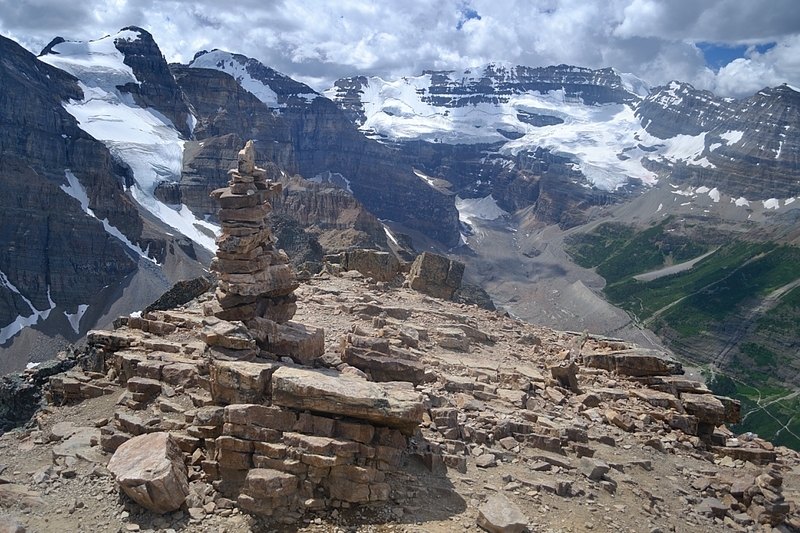The Bow Valley has some of Canada’s most popular mountain hikes, they attract countless visitors every season to take them on.

The following can be accessed from the Trans Canada west of Calgary and in the Bow Valley.
Heart Mountain: While most mountains in the Canadian Rockies are named after an explorer, Heart Mountain is named after the shape its two summit peaks create from the right angle: a giant heart.

To access it, just park at the Heart Creek Trailhead off the Trans Canada about 100km west of Calgary. From there, pick up the obvious trail back east and gain the ridge heading up.
There is one small rock step that requires a few third-class moves. Continue to the summit and the amazing views of the cirque behind.
Technical Details
Naming: The peak was named in 1957 for the heart shaped layer of limestone near the top.
Distance: 8km return
Elevation: 2,135 metres
Time: 5 to 8 hours return
First Ascent: First recorded in late 1800s.
Lady MacDonald: Parking near downtown Canmore and walking up a big mountain is one of the many bonuses of living in an alpine town.

Lady MacDonald dominates the sky north of Canmore as it rises up west of Cougar Creek. The trail at the mountain base is easy to reach and find after parking at the new paved parking area near Summit Café.
Follow the trail until you start to head up. You’ll pass a few steep sections, boulders, a ridge and a summit plateau before the final scree slope to the first summit. From there, take the knife-edge ridge to the main summit or head back down like most hikers.
Technical Details
Naming: Named in 1886 after Susan Agnes Macdonald, wife of Sir John A. Macdonald, first Prime Minister of Canada.
Distance: 12km return
Elevation: 2,606 metres
Time: 6 to 12 hours return
First Ascent: In 1886 by J.J. McArthur
Sulphur Mountain: Rolling away from Banff are a number of mountain ranges and one of them known as the South Banff Range has a classic peak to climb.

Sulphur Mountain was named after the Cave and Basin Hot Springs, a great way to spend the day is soaking in them, and has a gondola to the top.
A better way to reach the summit is by taking the low-grade switchbacking trail up the slope below the gondola and taking the gondola down, free during shoulder season.
At the top, you can dine in the restaurant, take the trail to Sanson’s Peak and check out the old weather observatory where researchers would live.
Technical Details
Naming: Named in 1916 for the hot springs on its lower slopes. George Dawson referred to it as Terrace Mountain on his 1886 map. Sanson’s Peak was named in 1948 for Norman Bethune Sanson who attended the observatory for nearly 30 years.
Distance: 6km car to summit
Elevation: 2,451 metres
Time: 3 hours to the top
First Ascent: First recorded in 1800s.
Tunnel Mountain: The mountain is nearly encircled by the town of Banff, save for a small section of river below the east face where rock climbers hang out.

It is one of the smallest mountains in the Park and in the 1800s was known as “The Hill.” There are many ways to get to the main trail up the slope, some adding a few minutes of steep hiking.
In 1900, famous mountain climber James Outram said of it, “The view will never be forgotten.”
Banff resident Anne Ness climbed it over 8,000 times over 40 years, certainly setting a high bar for anyone hoping to set a record.
Technical Details
Naming: The Stoney people had long called the mountain Sleeping Buffalo, but after a Canadian Pacific Railway engineer planned to tunnel the tracks through the mountain in the 1880s, it’s been known as Tunnel.
Distance: 8km return
Elevation: 1,692 metres
Time: 20 minutes to 1.5 hours
First Ascent: Unknown
Fairview Mountain: The most committing and serious hike, but still considered a mellow day by most in the mountains, on this list ascends a beautiful peak on the eastern shore of Lake Louise.

Fairview Mountain takes a little bit of effort to reach the top off, but the views are some of the most breathtaking in the Bow Valley.
After hiking up a forest to the saddle, you follow a switch-backing up scree to a blocky summit looking down on Lake Louise and across the Valley of the 10 Peaks.
Technical Details
Naming: Walter Wilcox named it in 1894 after seeing the view.
Distance: 10km return
Elevation: 2,744 metres
Time: 4 to 8 hours return
First Ascent: First recorded in 1893, but presumed before that by native explorer.